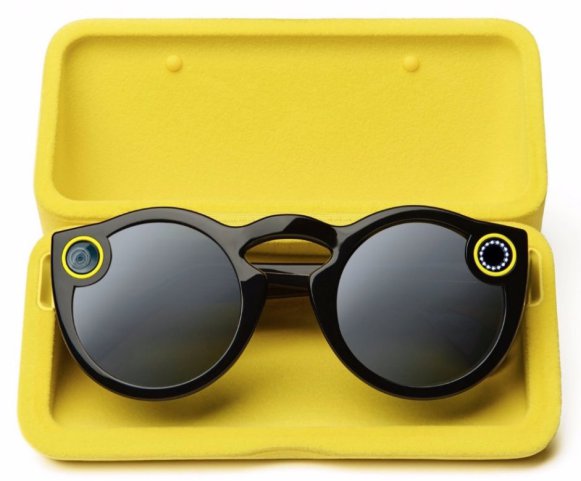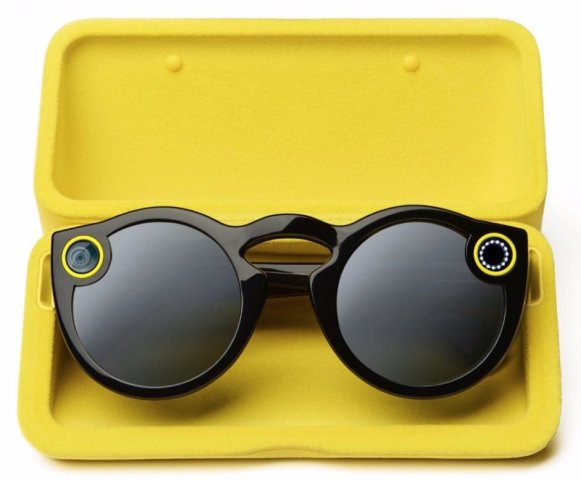
Snapchat is the only company cool enough to possibly dismantle the Google Glass stigma. Awkward, useless, and a threat to privacy are how many think of computers you wear on your face. Can Snapchat show off the masterful marketing and smooth execution required to produce a product that won’t die on stores shelves or in a desk drawer?
To quickly recount the basics, a video of Snapchat’s new camcorder sunglasses leaked last night. Business Insider reported it, so the company rushed out the news with a Wall Street Journal piece that was planned for Monday.
Snapchat is renaming its corporate self to Snap Inc, and launching its $130 Spectacles this fall in limited release. They’ll be one-size-fits all in black, teal, or coral colors. Spectacles let you tap the glasses’ rim to instantly record 10 seconds of video, three taps to record a maximum of 30 seconds, with a light on the front alerting people you’re recording.
The video is captured with an 115-degree wide view lens in a circular format that can be watched full-screen on a phone in any orientation. The video is stored on the device and can be wirelessly offloaded to a phone over Wifi or Bluetooth so users can edit and share via Snapchat later. Spectacles’ battery should last a day, and you can get up to four full recharges from the portable charging case.
But the real questions are whether people will want or need Spectacles when they already have a camera phone, how Snap Inc can avoid them becoming geeky or creepy, and how they might change the future of the startup and how we capture social media.

Spectacles and their charging case. via Business Insider
Here we’ll explore the pitfalls and potential glory facing Snap Inc’s Spectacles.
Headaches
Do We Need A Second Camera? – Everyone already carries remarkably powerful cameras in their pockets. The biggest challenge for Specs will be defeating the status quo: taking photos and videos with your phone. Hold your iPhone or Android up in front of your face with one hand, and the experience might be similar enough to Specs to make them unneccessary.

If you have Snapchat on your phone, do you need Spectacles? via Business Insider
Snap Inc will have to prove how different and awesome the 115-degree, circular, first-person format is. That might require getting Specs into the hands of some talented creators before a wider release.
 Specs have to nail more than footage of skateboarding and playing with kids. They will have to show versatility, and might need some Specs-only animated lenses, filters, or other image embellishments to differentiate them enough from the super-engineered cameras in our iPhones.
Specs have to nail more than footage of skateboarding and playing with kids. They will have to show versatility, and might need some Specs-only animated lenses, filters, or other image embellishments to differentiate them enough from the super-engineered cameras in our iPhones.
Spectacles raise the larger question of whether cameras are so important that sometimes we’ll want a dedicated non-professional capture device even if we have to remember to carry it around and charge it. Or whether the convenience and power of our always-with-us smartphone cameras do a good enough job already.
Hands Are More Agile Than Heads – Try shooting video at a crowded concert from eye-level instead of thrusting your phone in the air, and you’ll quickly appreciate having your camera in your nimble hands, not strapped to your head. Getting the best angle often requires some maneuvering that’s much easier with your arms involved.
Footage from Specs could come out shaky and jerky unless Snapchat can work in some auto-stabilization magic. Otherwise the videos they make could be dizzying or too hectic to watch.
 ReSPECtability – Google Glass got handed to geeky developers and techies first, who quickly associated the device with awkward social behavior and an “I’m better than you because I’m from the future” attitude. The infamous Scoble shower Glass photo still haunts the wearable industry.
ReSPECtability – Google Glass got handed to geeky developers and techies first, who quickly associated the device with awkward social behavior and an “I’m better than you because I’m from the future” attitude. The infamous Scoble shower Glass photo still haunts the wearable industry.
Reversing this stigma will require Snap Inc to carefully manage first impressions to make Spectacles aspirational, not deplorable. Unfortunately the “trying to be artful” portraits of Snap CEO Evan Spiegel wearing them are already establishing a slightly pretentious aura.

Snap Inc CEO Evan Spiegel makes Spectacles seem a bit prtentious in this photo by Karl Lagerfield for WSJ
Private Eyes, They’re Watching You – Snap was smart to make it obvious when Spectacles are recording with a big warning light. But after “Are your recording me!?!” scuffles in bars and businesses putting up “No Google Glass” signs, people are sure to be a little uneasy.
We’re used to someone having to raise and aim their camera or phone at us before they’re able to record us, which gives us time to modify our behavior or turn away. Knowing that Spectacles could start shooting with a quick touch, even with the warning light, could make people uncomfortable being around anyone wearing them.
Snap will have to find some way to communicate polite practices for how to use Specs before someone crosses the line and ignites controversy.
Hopes
Live Life, Don’t Just Record It – Better cameras, network connections, and social networks have led to an explosion of lifecasting, led by Snapchat Stories (and copied by Instagram Stories). But they pose a risk to the way we experience our greatest moments.
When something special happens, today most people bust out their phones rather than bask in the moment. Fans in the front row destroy their chance to connect with their rock star heroes by thrusting a phone between them. Then, people divorce themselves from the action while they stare down, editing their content with filters and captions before sharing.

Spectacles let you live life rather than stare at your phone
Snapchat’s recently launched Memories feature fights the second part of that sequence by letting you save what you record so you can edit and share later when you have some downtime. Spectacles could fix the first, removing the foreign object of the phone from the capture process. There’s still a device in the way, but at least it’s translucent, so you see the world directly while recording an identical view.
Spectacles could actualize the metaphor of creating a window into each other’s lives, instead of watching our own lives unfold on a screen.
The Camera Company – Building the camera itself rather than just the software gives Snap Inc a tighter grip on the experience. It could include hardware that wouldn’t fit in a phone. It can experiment more dramatically with how people record. And it provides deeper ownership of the data that comes out, which will be tucked in Snapchat Memories.
Even if video ads remain Snap’s core way to earn money, diversifying beyond video ads could boost confidence in the startup’s expected IPO. Snapchat could earn $200 million if it can get just one percent of its daily users to buy them. The more of their stack a company owns, the more it can control its destiny. If Facebook is the News Feed, and Google is search, Snapchat wants to be the camera.

Augmented Reality – Spectacles v1 only record the world around you, but future iterations could enhance it. Eventually, perhaps they could automatically give everyone a mustache, highlight your friends in a crowded room, let you watch other people’s Spectacles content like you were seeing through their eyes, or host a developer platform with untold applications.
Snapchat’s selfie lenses were the first delivery of AR to the masses, and the company has been staffing up with experts who could build the next wave of augmentation. Perhaps they’ll add voice control or other IoT integrations in the future.
Scenes We’ve Never Seen – What’s it like to walk down the red carpet? We’ve seen plenty of footage following a celebrity, but Spectacles could let us be the center of attention with fans and paparazzi fawning around us. We might get to see a concert from the singer’s eyes, or walk to runway as a fashion model
Though Snapchat has always been for teens, parents might love the ability to hold their baby with both hands while recording. GoPro built the idiot-proof adventure camera, but Snap could build one for saving everyday joys.

An Aspirational Device
The marketing of Spectacles is an enormous opportunity for Snap Inc, but one fraught with peril. Initial perceptions could make or break Specs, and perhaps define how fast or slow we’ll adopt other types of head-worn computers.

The most sensible strategy might mimic that of the acquirer Snapchat spurned. Facebook became an international hit in part because people desperately wanted to join what was seen as an exclusive, elite club.
Each stage of Facebook’s rollout expanded it a rung down the social hierarchy. This way the next demographic to get it always idolized the last. Harvard, then elite US colleges, other American colleges, international colleges, high schools, and eventually everyone. It’s the opposite of how Google bungled roll outs of Google Glass (weird developers first) and Google+ (geographically and socially unclustered tech elite first).
Snapchat might be best putting Spectacles on the faces of aspirational figures first — widely respected yet hip celebrities. If the first content coming out of Spectacles include the perspective of stars from classy movie premiers, epic concerts, raucous parties, and stunning sporting events, it could cement the idea that people you want to be wear them.
Similarly, Snapchat might only want to distribute the original pairs of Specs through some kind of trusted network of influencers. And when it sells them publicly, it might be best to start in cultural capitals like LA and NYC, where the world already looks for what’s cool.

Spectacles need to feel aspirational. via Business Insider
Spectacles are a gadget that won’t be judged by their specs, but by whether they can change human behavior. Cramming new ways to act into our society will always be tougher than packing processing power into a chip. Overwriting the disgust instilled by Google Glass will take all of Spiegel’s skills.
We might assume that one day, eyewear computers will shrink and strengthen to the point they become commonplace. But maybe Snap Inc has the stylish reputation and daredevil ambition to make that day come much sooner.

